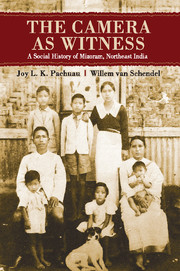Book contents
- Frontmatter
- Contents
- List of Figures
- List of Maps
- Acknowledgements
- I Becoming Mizo
- 1 Introduction
- 2 Coming into View: The First Portraits
- 3 Adjusting Mizo Culture
- 4 Domesticating a New Religion
- 5 Getting Educated
- 6 Controlling the Hills
- 7 The Trouble of Travel
- 8 First Stirrings of the Market Economy
- 9 Mizos in the World Wars
- 10 Mizo Visual Sensibilities
- II Mizoram in the New India
- III Visions of Independence
- IV Mizo Modernities
- Copyrights and Sources
- Glossary
- Bibliography
- Index
2 - Coming into View: The First Portraits
from I - Becoming Mizo
Published online by Cambridge University Press: 05 May 2015
- Frontmatter
- Contents
- List of Figures
- List of Maps
- Acknowledgements
- I Becoming Mizo
- 1 Introduction
- 2 Coming into View: The First Portraits
- 3 Adjusting Mizo Culture
- 4 Domesticating a New Religion
- 5 Getting Educated
- 6 Controlling the Hills
- 7 The Trouble of Travel
- 8 First Stirrings of the Market Economy
- 9 Mizos in the World Wars
- 10 Mizo Visual Sensibilities
- II Mizoram in the New India
- III Visions of Independence
- IV Mizo Modernities
- Copyrights and Sources
- Glossary
- Bibliography
- Index
Summary
The visual record of the hill people begins in the 1860s. At that time drawings and watercolours were very popular, and most early images of peoples on the frontiers of British expansion came from the sketchbooks of soldiers and adventurers. However, photography, a revolutionary new visual form, had recently become available. Even so, for a longer time than we often realize, photography remained in competition for historical authority in reportage with other visual media (sketches, watercolours, lithographs, oil paintings).
Photographs promised an objective representation of visual realities, a scientific way of recording whatever met the eye. Many contemporaries believed that photographs were superior because they provided mechanical and hence value-free visual truths: ‘the photograph promised to replace the meddling, weary artist’. It was only later that observers began to realize that ‘photography does not transcend the social context in which it is produced, circulated and read. Cultural, economic and political forces all determine both the content of photographs and the ways in which they are interpreted and reproduced … photography requires human agency and thus enters rather than ends the debate over neutrality’.
Photography spread rapidly in colonial India, but the unwieldy and fragile cameras of the 1860s and 1870s were hardly suited to the rough terrain that the hill people inhabited. And yet, surprisingly, the very first surviving images of people in these hills are photographic ones. And they are spectacular. In an age when Europeans usually photographed newly encountered groups as anonymous ‘anthropological types’, the first photographic images of these hill people are sensitive portraits, often of named individuals. These images are the work of an unusual British official, Thomas Herbert Lewin. He was the man in charge of the Chittagong hills after their annexation in 1860. Keen to write about the hill people, he explored beyond the frontiers of his territory and took pictures as illustrations for future books. Figure 2.1 is a good example. It shows a turbaned man looking steadily into the camera lens.
- Type
- Chapter
- Information
- The Camera as WitnessA Social History of Mizoram, Northeast India, pp. 24 - 35Publisher: Cambridge University PressPrint publication year: 2015

